Abstract
A fabric-like electromagnetic (EM) shielding composite based on nonwoven was fabricated using a coating method with a mixture containing graphene (GE) nanosheets and polyvinylidene fluoride (PVDF) adhesive agent, and then characterized for its mechanical properties, air permeability, EM properties, and morphologies. The GE loading amount and EM shielding effect was improved by applying a double coating process, with, in particular, a 2-sided coating that produced superior air permeability and shielding effectiveness (SE) than 2-layer coating. The coating produced an increased tensile initial modulus and flexural rigidity, whose increase was affected by the coating agent GE content. Increased GE content also resulted in decreased air permeability and increased SE and electrical conductivity. After coating with 25 g/L GE, the composite SE reached 31.2 dB, such that the electric/magnetic field strength of transmitted EM waves were reduced by ~97%. Scanning electron microscope and energy dispersive spectrometry results illustrated that aggregated GE was tightly bonded with the fibers due to the adhesive effect of PVDF and, with the increased coating agent GE content, the fibrous network was gradually filled with GE/PVDF attachments and increasing numbers of fibers were covered. Such an EM shielding material could be referenced for development by industrial or household protective applications.
1. Introduction
Electromagnetic (EM) waves are now everywhere and the hazardous effects of EM radiation on our health and activities have been reported []. EM shielding materials are attracting great attention due to their specific function in overcoming EM interference (EMI) problems and are in demand for medical, aerospace, and military applications []. Many materials have been explored as EM shielding materials [,,], and among them, EM shielding fabric is an important new kind of material or product for EM shielding because of its softness, breathability, and easy machining [].
There are two main means for endowing fabrics or textiles with EM shielding performance. One is the use of conductive fibers or yarns, such as copper fibers [] and stainless steel fibers [], in textile fabrication, which transforms a textile that is normally EM transparent into a fairly good EM shield. Optional conductive fibers mainly include nickel, copper, and carbon fibers. The other involves metal-coating or plating the surfaces of fabrics or constituent fibers and thus providing the fabrics with EMI shielding functionality. The common plating techniques include chemical plating [], electroplating [], vacuum plating, and magnetron sputtering (plasma plating) []. In most cases, fabrics with a conducting layer mainly provide EM reflection due to the deposited metal.
As a special fabric, nonwoven fabric has attracted great interest in energy-related applications because of its random structural orientation, high porosity, and low cost [,]. Its safety level in face mask and protective clothes, economy of scale, and fast supply response has been confirmed during the coronavirus disease 2019 (COVID-19) pandemic. The two means mentioned above for EM shielding fabrics can also be considered for endowing nonwoven with EM shielding performance, but there are high technical requirements. In contrast to the two methods, EM-functional coated nonwoven are produced easily by adding conductive materials into the fabric coating agent, thus forming a shielding layer attached to the nonwoven surface. However, such a coated nonwoven has limited application due to its air impermeability, stiffness to touch, and insufficient shielding effect, thus the related research has been scanty. Therefore, an optimized coating process is needed, in which the fabric coating agent contains wave-shielding material and a polymer adhesive agent. Different from a common film-forming agent, the polymer adhesive agent is used for attaching wave-shielding material to the nonwoven base.
Many electrically conductive nanomaterials are appropriate for this process and, among these, graphene (GE) nanosheets have been intensively investigated as a new type of carbon-based nanomaterial with the advantages of ultrahigh surface area, excellent mechanical flexibility, and electrical conductivity [,,]. These outstanding features make them an excellent option for creating conductive networks attached to a nonwoven framework for EMI shielding.
In this study, a simple coating–drying method was used for attaching GE nanosheets to spun-laced nonwoven fabric consisting of polyethylene terephthalate (PET) fibers, with a high viscosity polyvinylidene fluoride (PVDF) used as the adhesive between nanosheets and nonwoven base. The resultant composites from this simple method showed EMI shielding performance influenced by the coating process and GE content in the coating agent. The micromorphology, mechanical properties, air permeability, and electrical conductivity were also investigated.
2. Experimental
2.1. Materials
Spun-laced PET nonwoven fabric (normal gram weight 100 g/m2) was provided by Foshan Jedal Nonwoven Corp., Ltd. (Foshan, China). GE nanosheets (KNG-G2, 1–3 layers, flake size 7–12 μm) were obtained from Xiamen Knano Graphene Technology Corp., Ltd. (Xiamen, China). PVDF powder (Solef 6020) was obtained from Solvay Chemical Industry Corp., Ltd. (Shanghai, China). N,N-dimethylacetimide (DMAc), sodium hydroxide (NaOH), and sodium dodecyl sulfate (SDS) were obtained from Kermel Chemical Reagent Corp., Ltd. (Tianjin, China).
2.2. Preparation of Nonwoven Based Composites
A coating process was used for the fabrication of nonwoven-based composites and the coating machine and coating component are shown in Figure 1. Nonwoven fabric used as the base material was first cleaned in an aqueous solution containing 4 g/L NaOH and 2 g/L SDS, then rinsed with pure water, and dried at 60 °C for 2 h. GE dispersions with various GE content (0–25 g/L relative to coating agent) were prepared by adding GE into DMAc followed by ultrasonic treatment, then adding 40 g/L PVDF into the dispersions, and coating agents finally obtained by PVDF dissolution under continuous magnetic stirring.
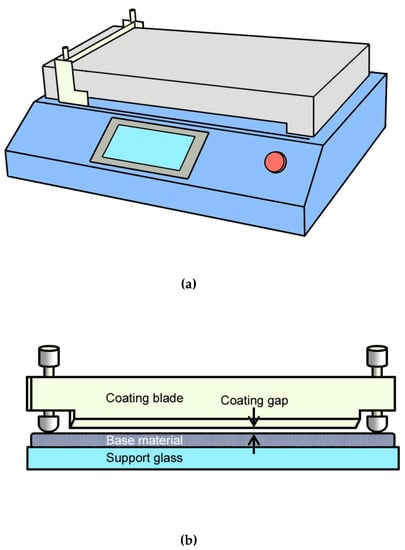
Figure 1.
Schematic diagram of fabricating equipment: (a) coating machine and (b) coating component.
The coating agents were uniformly coated on the nonwoven surface through doctor blade method via the coating machine, in which the nonwoven was supported by a plate glass and the gap between the coating blade and nonwoven controlled to 200 μm. Finally, the coated nonwovens were dried in a 70 °C air circulation oven for 2 h to yield nonwoven-based composites with a single-layer (1-layer) coating. For double-layer (2-layer) or double-sided (2-sided) coating, the coating and drying process was repeated. Control of the coating gap was facilitated by directing a second coating perpendicular to the last coating.
2.3. Characterization
2.3.1. Morphological and Elemental Analysis
The surface morphology of nonwoven and various composites and their element distribution were tested and analyzed by scanning electron microscope (SEM; Zeiss Supra 55, Carl Zeiss AG, Oberkochen, Germany) and associated energy dispersive spectrometry (EDS), respectively.
2.3.2. Fundamental Properties
The thickness of nonwoven and composites was tested using a portable thickness gauge. Their gram weight (planar density) was measured through weighing and calculated according to Equation (1).
where ρ is the gram weight (g/m2), m the mass (g), and A the area (m2).
2.3.3. Mechanical Properties
The tensile properties, including breaking force, elongation at break, and initial modulus, were tested using an electromechanical universal testing machine (CMT4204, MTS Industrial System (China) Co., Ltd., Shenzhen, China). Nonwoven and composites were cut into strips 1 cm wide and used for tensile testing, where the gripping range and tensile rate were 100 mm and 100 mm/min, respectively.
Flexural rigidity was evaluated by the bending length through a cantilever beam method. Two-centimeter wide strips were used as test specimens and their bending length was calculated according to Equation (2).
where C is the bending length (cm), L the cantilever extension length (cm), and θ the angle between the line from the fixed point to free end and the horizontal plane.
2.3.4. Air Permeability
The air permeability of nonwoven and composites was tested by a digital fabric air permeability tester (YG (B) 461N, Changzhou Detu Precision Instruments Co., Ltd., Changzhou, China), with the differential pressure across the samples set to 200 Pa.
2.3.5. Electromagnetic Properties
Composite electrical conductivity was assessed through direct current electrical resistance measurements. Nonwoven-based composites were cut into strips 1 cm wide and 10 cm long and their electrical resistance measured using an electrical resistance tester (TH2683, Changzhou Tonghui electronics Co., Ltd., Changzhou, China). Their electrical conductivity was calculated according to Equation (3).
where σ and R are the electrical conductivity (S/cm) and resistance (Ω) of the strips, respectively, and l, d, and δ the length, width, and thickness of the strips (cm), respectively.
The EMI shielding effectiveness (SE) of the composites was measured using the coaxial cable line test method based on ASTM 4935-2010 standard. A fabric EM SE tester (DR-913G, Wenzhou Darong Textile Instrument Co., Ltd., Wenzhou, China) was employed, consisting of a vector network analyzer and coaxial cable line with a vertically lifting sample holder, for testing SE over a frequency range of 100–3000 MHz.
Five runs were performed for each test, and the average value and standard deviation were used for the analysis.
3. Results and Discussion
3.1. Selection of Coating Process
Nonwoven-based composites were fabricated with 25 g/L GE coating and the various coated materials, including 1-layer, 2-layer, and 2-sided coating, compared for their influence on composite structure and performance. First, the structures of nonwoven and the composites from various coating processes were observed using SEM micrographs (Figure 2). Three-dimensional network structures with random-oriented fibers were clearly seen in the pristine nonwoven sample, which was also observed in coated composites which had an amount of attachments. Notably, no dense layer was formed on composite surfaces with a 1-layer coating and the attachments were GE nanosheets dominant. PVDF, which has a high molecular weight (MW), added in low concentration (40 g/L) led to poor film-forming. Meanwhile, the high MW endowed the coating agent with adequate viscosity, which favored the coating operation. GE loading was improved by coating the nonwoven twice on the same side, such that the composite was observed as a fibrous network wholly covered by a dense layer. Here, surface pores from the first coating were blocked during the next coating, which would cause some unfavorable influence on composite permeability. To overcome this issue, a 2-sided coating was carried out and the resulting composite was observed to have surfaces similar to the 1-layer coating and without a dense layer on both sides. Coating both sides appeared to have little impact on either side because of the limited infiltration of the viscous coating agent into the nonwoven network.
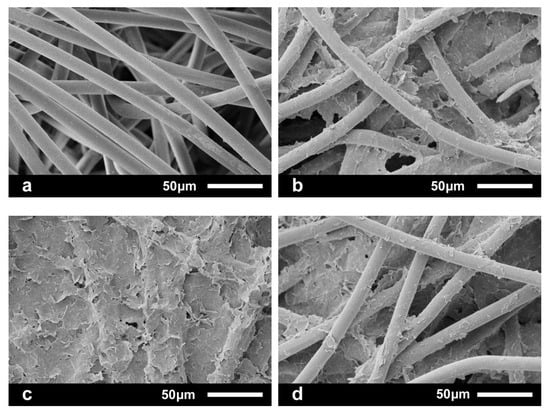
Figure 2.
SEM images of nonwoven and composites from various coating processes. (a) No coating, (b) 1-layer coating, (c) 2-layer coating, and (d) 2-sided coating.
The related fundamental properties (thickness and gram weight) of the composites were also influenced by the coating process (Table 1). The thicknesses and gram weights were observed to be increased from nonwoven to the composites through the coating process. Although a coating layer was not completely formed in some composites, the GE dominant attachments located in the framework reduced composite compressive deformation during thickness measurements, which resulted in larger thickness values. Meanwhile, the total weight related to the gram weight would be higher for composites with attachments. Moreover, a double coating produced higher thickness and gram weight than the 1-layer coating because of the increased amount of attachments. However, it was noticed that composite with a 2-layer coating had a lower gram weight than a 2-sided one, which reflected the relatively lower GE content, because the first coating prevented the infiltration of the coating agent during the repeating process on the same side.

Table 1.
Fundamental properties of nonwoven and composites from various coating processes.
The mechanical properties of nonwoven and composites were characterized through tensile and bending tests. These tensile properties changes included increased breaking force and decreased elongation at break for all composites after the coating process, but the variation was indistinct (Table 2). Notably, the initial modulus of pristine nonwoven (15.5 MPa) was much below that of the composites due to transformation of the network structure from a loose condition to a jammed condition in the initial tensile stage. GE attachments, which consolidated the network, thus restrained the initial transformation of the composites. The deformation process was tracked by referring to tensile curves described later in this study. Also, 2-sided coating composites exhibited a higher initial modulus than other composites, which was in connection with its high GE loading mentioned above.

Table 2.
Tensile properties of nonwoven and composites from various coating processes.
Different from the above tensile properties, bending length measured from the cantilever beam method reflected flexural behavior, an important feature in evaluating wearability and style. The nonwoven was seen to possess low bending length and exhibited cloth softness (Figure 3). Composites showed distinctly increased bending length, especially with 2-sided coating, which was also related to the amount of GE attachments. The network structure was consolidated in these composites, endowing them with stiffness, which was not good for wearability but suitable for other protection applications such as protective packaging.
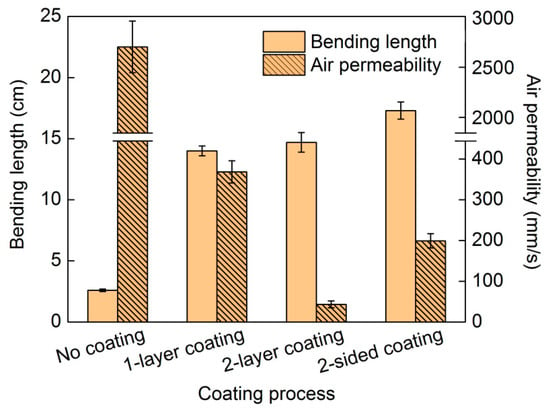
Figure 3.
Bending length and air permeability of nonwoven and composites from various coating processes.
The air permeability of nonwoven and composites showed that raw nonwoven had far higher air permeability (2701 mm/s) than all the composites due to its loose network structure (Figure 3). With the network interspaces partly filled by GE attachments after coating, there was a clear retardation of air penetration. In particular, extremely low air permeability (43.4 mm/s) was detected for 2-layer coating composites, because of the dense layer formed by coating the same side twice (Figure 2c). This poor air permeability limited the application range of this fabric-like material to some extent, while the composite with 2-sided coating possessed slightly better air permeability than 2-layer coating and more suitable for the further application study.
EM properties, including EMI SE and electrical conductivity, were measured, with the EMI SE measured at a 1400 MHz incident frequency based on the coaxial cable line test method and electrical conductivity was obtained by resistance measurement (Figure 4). The EMI SE and conductivity of PET nonwoven fabrics was barely detectable, because PET owned high electrical insulation, and electrical conductivity is an important factor affecting the EM shielding performance of a material []. Composites after coating exhibited increasing SE and conductivity with increased coating cycles and 2-sided coating generated relatively better shielding effects and conductivity. GE nanosheets attached to the nonwoven framework formed a conductive layer or network whose connectivity mostly depended on GE loading amount, which was considered to be an important factor for EMI shielding by absorption. In addition, PVDF as the adhesive agent had little impact on the connectivity because of its low dosage. As mentioned above, the 2-sided coating led to relatively higher GE loading content, such that the resultant composite achieved better SE and conductivity than the others.
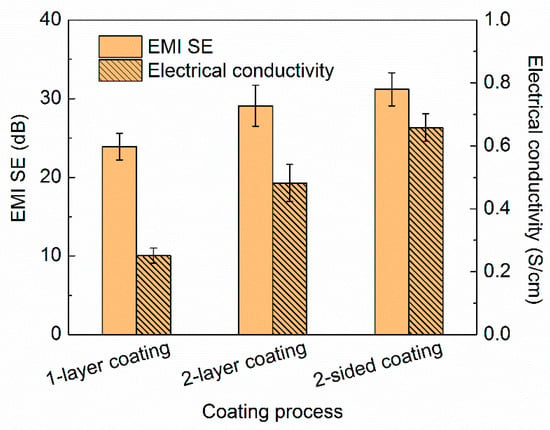
Figure 4.
Electromagenetic interference shielding effectiveness (EMI SE) at 1400 MHz and electrical conductivity of composites from various coating processes.
The effects of the coating process on composite properties were explored, particularly focusing on the air permeability and EMI SE to obtain the desired outcome. Considering air permeability and SE, 2-sided coating process was selected and used in further examinations. Furthermore, this coating produced nonwoven-based composites with superior EMI SE, while also having acceptable air permeability.
3.2. Effects of GE Content
Per the above discussion, the EMI SE of the composites was largely determined by their GE loading, which could be adjusted by raising the GE content in coating agent. The effects of GE content were investigated with 2-sided coated samples. Composite thicknesses and gram weights were shown to have a roughly increasing tendency with increased GE content (Table 3). This was easily explained as follows: The high GE-content coating agent introduced more GE nanosheets into the nonwoven framework, thus increasing the total weight. Meanwhile, more GE nanosheets attached to the network reduced thickness values measured under a set loading pressure. During this experiment, it was also noticed that the coating agent viscosity increased with increased GE content because coating agent flow was retarded by the abundance of flake-like GE, and GE nanosheets were difficult to fully disperse in DMAc when their content exceeded 25 g/L. Therefore, when GE nanosheets were added at 25 g/L into the coating agent, the composite gram weight was elevated to 132.0 g/m2 and thus the higher GE loading would favor EMI shielding performance.

Table 3.
Fundamental properties of composites with various coating agent GE content.
The mechanical properties of nonwoven and composites with various GE content in the coating agent were investigated (Figure 5). Notably, the composites exhibited clearly different tensile curves compared with pristine nonwoven, with a rapid increase in composite tensile force in the initial tensile stage, while the increase in tensile force was slow for raw nonwoven. All samples exhibited differences in breaking point as well. This trend was explained as follows: On one hand, the fibrous network was consolidated by the adhesive agent, which led to an increased breaking force and a decreased elongation at break. However, this impact exhibited little variance with GE content because of similar bonding effects from PVDF on the fibrous network in these composites. On the other hand, the GE attachments loaded onto the composites restrained deformation of network interspaces and also led to increased initial modulus with increased GE attachment, which was positively associated with coating agent GE content. The bending length was observed to have a similar variation to initial modulus, which was also related to PVDF bonding effects and impediment by GE attachments. Furthermore, the different stiffness would appropriate for different applications.
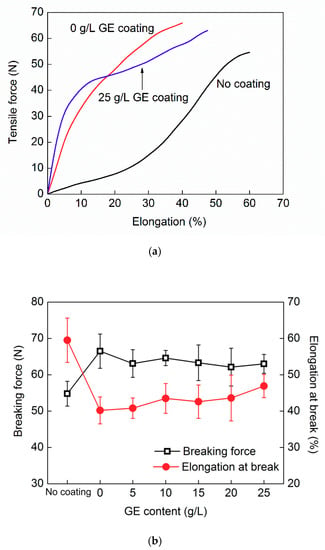
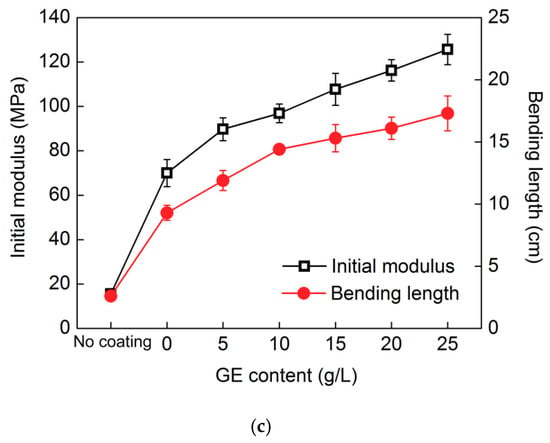
Figure 5.
Mechanical properties of nonwoven and composites with various coating agent GE content. (a) Tensile curves, (b) breaking force and elongation, and (c) initial modulus and bending length.
The air permeability of these composites was correlated reciprocally with an increase in coating agent GE content from 0 to 25 g/L leading to a decrease in the composite air permeability from 958.0 to 199.3 mm/s (Figure 6). As mentioned above, filling by GE attachments in the fibrous network retarded air penetration, with the GE attachment amount positively associated with GE content in the coating agent. Therefore, the air permeability could be regularly adjusted by altering GE content. With the air permeability meeting certain application requirements, the EMI shielding performance for these composites appeared more significant.
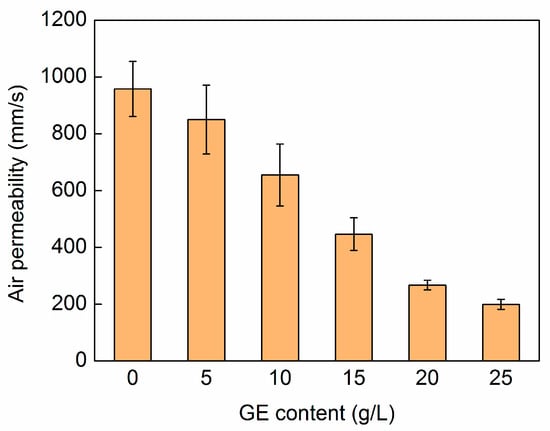
Figure 6.
Air permeability of composites with various coating agent GE content.
The main objective of this study was to endow nonwoven-based composites with good EMI shielding performance that could also be adjusted by controlling the GE content in the coating agent. The SE curves of various composites over an incident frequency range of 100–3000 MHz showed that all composites presented a similar SE variation trend over this frequency range and SE curves showed regular fluctuations, with 3 peaks located in 350, 1400, and 2350 MHz (Figure 7a). Composite coated using neat PVDF solution, without GE, was transparent to EM waves, thus having SE values of 0 dB. With increased GE, composite SE improved over the whole frequency range. Typically, the SE at 1400 MHz increased with increased GE content, exhibiting an approximately linear relationship (Figure 7b). For samples subjected to coating with 25 g/L GE, its EMI SE reached 31.2 dB, which was higher than nanoscale silver-coated textiles (~19 dB) through in situ synthesis proposed by Kardarian et al. []. The electric and magnetic field strength of transmitted EM waves was reduced by ~97% according to the definition of SE [], represented by Equation (4).
where Ei and Eo are the root mean square of incident and transmitted electric field strength and Hi and Ho the root mean square of incident and transmitted magnetic field strength, respectively.
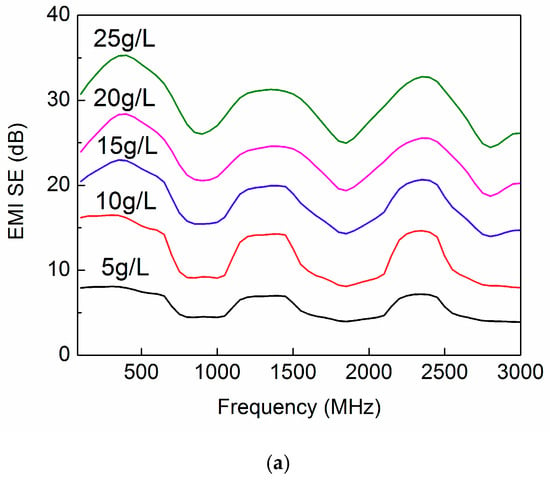

Figure 7.
Electromagnetic properties of composites with various GE content in coating agent. (a) Variation of EMI SE with incident frequency from 100 to 3000 MHz and (b) EMI SE at 1400 MHz and electrical conductivity.
The EMI SE of the composites was strongly related to their electrical conductivity. More GE nanosheets introduced into the nonwoven base through the coating process resulted in increased conductivity, which has been discussed above. In addition, a high GE/PVDF ratio in the coating agent was beneficial to conductivity by attachments after drying, which was also important to composite conductivity. The conductivity curve was observed to have a shape different from that of the SE curve (Figure 7b), which was partly because SE was on a logarithmic scale (Equation (4)) while conductivity was on a linear scale. Overall, the EMI SE and electrical conductivity had been purposely designed in this way.
3.3. Morphological and Elemental Analysis
The microstructures of nonwoven-based composites with various coating agent GE content were observed by SEM images (Figure 8). When neat PVDF solution, without GE, was coated on nonwoven surfaces, the fibers were adhered together to a certain extent by the coating agent, but the attachment was barely observed, because PVDF just acted as an internal adhesive. With increased GE content, the fibrous network was gradually filled with GE attachments tightly bonded with the fibers due to PVDF’s adhesive effect. As mentioned above, neat PVDF solution had low viscosity and easily infiltrated the loose net structure during the coating process, thus a coating layer was difficult to form on nonwoven surfaces. Coating agent with higher GE content possessed higher viscosity and formed bridges between the fibers, favoring the formation of an interconnected conductive network.
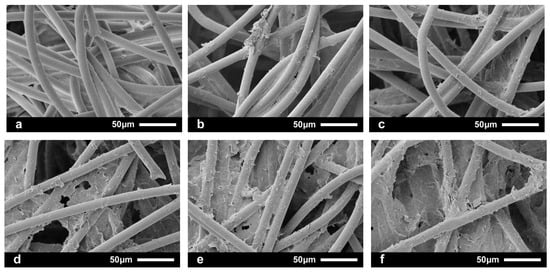
Figure 8.
SEM images of composites with various GE content in coating agent, with (a) 0, (b) 5, (c) 10, (d) 15, (e) 20, and (f) 25 g/L.
The spreading state of coating agent on nonwoven surfaces was also examined through EDS analysis. Three samples, namely uncoated nonwoven and coated with 0 and 25 g/L GE were characterized in terms of surface element distribution (Figure 9 and Figure 10). According to the normalized element mass fractions, the PET nonwoven surface consisted of carbon (C) and oxygen (O) (Table 4). After coating with neat PVDF solution, a small proportion of fluorine (F, 9.17 wt%) was detected on the composite surface, which was attributed to a little PVDF on composite surfaces, due to the low viscosity of neat PVDF solution, as mentioned above. For composite coated with 25 g/L GE, there was clearly a decreased O percentage and increased F percentage on its surface, which illustrated that most PET fibers were covered by GE/PVDF attachments. Overall, this surface element distribution through EDS analysis corresponded to the preceding SEM results.

Figure 9.
Photos of nonwoven and composites. (a) No coating; coating with (b) 0 and (c) 25 g/L GE.
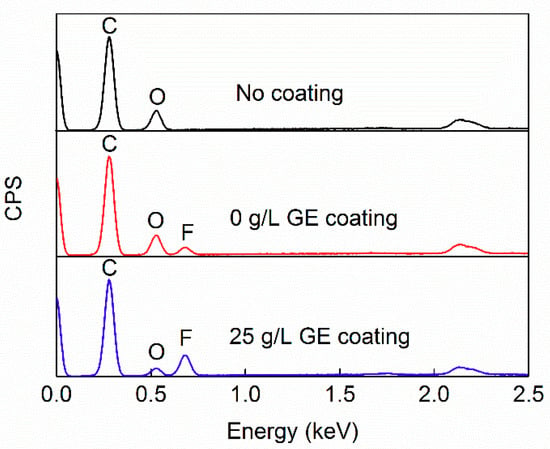
Figure 10.
Surface energy dispersive spectrometry (EDS) analysis of nonwoven and composites.

Table 4.
Element distribution on the surface of nonwoven and composites.
4. Conclusions
A nonwoven-based composite with EMI shielding performance was fabricated through a coating-drying process with a coating agent containing GE nanosheets and PVDF adhesive agent. The resulting composites were then characterized in terms of foundational properties, mechanical properties, air permeability, EM properties, morphologies, and surface element distribution. The GE loading and related EM shielding effects were improved by coating the nonwoven twice. A 2-side coated nonwoven exhibited superior air permeability and EM SE compared to a 2-layer coating on one side, and was selected for further study. The coating exhibited increased tensile initial modulus and flexural rigidity whose increase was influenced by GE content in the coating agent. Increased GE content also resulted in decreased air permeability and increased EMI SE and electrical conductivity that could be adjusted by GE content. For composites with 25 g/L GE coating, the SE reached 31.2 dB and electric and magnetic field strength of the transmitted EM waves reduced by ~97%. SEM and EDS results illustrated that GE aggregation on the nonwoven was tightly bonded with fibers due to PVDF′s adhesive effect and, with increased GE content, the fibrous network was gradually filled with GE/PVDF attachments and more PET fibers covered by attachments. A fabric-like EM shielding product was designed and trial-produced in this study, which could be referenced for industrial or household protective applications.
Author Contributions
Methodology, Z.F. and R.L.; investigation, Z.F. and X.C.; writing—original draft preparation, Z.F.; writing—review and editing, R.L.; funding acquisition, R.L. All authors have read and agreed to the published version of the manuscript.
Funding
This research was funded by National Key R&D Program of China (grant number 2017YFB0309100).
Institutional Review Board Statement
Not applicable.
Informed Consent Statement
Not applicable.
Data Availability Statement
The data presented in this study are available in the article.
Conflicts of Interest
The authors declare no conflict of interest.
References
- Gupta, A.; Choudhary, V. Electrical conductivity and shielding effectiveness of poly (trimethylene terephthalate)/multiwalled carbon nanotube composites. J. Mater. Sci. 2011, 46, 6416–6423. [Google Scholar] [CrossRef]
- Liu, X.X.; Zhang, Z.Y.; Wu, Y.P. Absorption properties of carbon black/silicon carbide microwave absorbers. Compos. Part B Eng. 2011, 42, 326–329. [Google Scholar] [CrossRef]
- Yusoff, A.N.; Abdullah, M.H.; Ahmad, S.H.; Jusoh, S.F.; Mansor, A.A.; Hamid, S.A.A. Electromagnetic and absorption properties of some microwave absorbers. J. Appl. Phys. 2002, 92, 876–882. [Google Scholar] [CrossRef]
- Li, Y.; Chen, C.X.; Zhang, S.; Ni, Y.W.; Huang, J. Electrical conductivity and electromagnetic interference shielding characteristics of multiwalled carbon nanotube filled polyacrylate composite films. Appl. Surf. Sci. 2008, 254, 5766–5771. [Google Scholar] [CrossRef]
- Pan, Y.F.; Yin, D.W.; Yu, X.F.; Hao, N.Y.; Huang, J.T. Multilayer-structured wood electroless Cu-Ni composite coatings for electromagnetic interference shielding. Coatings 2020, 10, 740. [Google Scholar] [CrossRef]
- Tugirumubano, A.; Vijay, S.J.; Go, S.H.; Kwac, L.K.; Kim, H.G. Investigation of mechanical and electromagnetic interference shielding properties of nickel-CFRP textile composites. J. Mater. Eng. Perform. 2018, 27, 2255–2262. [Google Scholar] [CrossRef]
- Cheng, K.B.; Cheng, T.W.; Nadaraj, R.N.; Giri Dev, V.R.; Neelakandan, R. Electromagnetic shielding effectiveness of the twill copper woven fabrics. J. Reinf. Plast. Comp. 2006, 25, 699–709. [Google Scholar] [CrossRef]
- Shyr, T.W.; Shie, J.W. Electromagnetic shielding mechanisms using soft magnetic stainless steel fiber enabled polyester textiles. J. Magn. Magn. Mater. 2012, 324, 4127–4132. [Google Scholar] [CrossRef]
- Han, E.G.; Kim, E.A.; Oh, K.W. Eletromagnetic interference shielding effectiveness of electroless Cu-plated PET fabrics. Synthetic. Met. 2001, 123, 469–476. [Google Scholar] [CrossRef]
- Yu, D.; Li, W.Y.; Wang, W.; Zhang, J.J. Preparation and properties of copper-silver complex plating on PET fabrics. Fiber. Polym. 2015, 16, 23–30. [Google Scholar] [CrossRef]
- Yu, X.Z.; Shen, Z.G. Metal copper films coated on microparticle substrates using an ultrasonic-assisted magnetron sputtering system. Powder. Technol. 2008, 187, 239–243. [Google Scholar] [CrossRef]
- Thilagavathi, G.; Pradeep, E.; Kannaian, T.; Sasikala, L. Development of natural fiber nonwovens for application as car interiors for noise control. J. Ind. Text. 2010, 39, 267–278. [Google Scholar] [CrossRef]
- Tascan, M.; Vaughn, E.A.; Stevens, K.A.; Brown, P.J. Effects of total surface area and fabric density on the acoustical behavior of traditional thermal-bonded highloft nonwoven fabrics. J. Text. Inst. 2011, 102, 746–751. [Google Scholar] [CrossRef]
- Xia, F.N.; Farmer, D.B.; Lin, Y.M.; Avouris, P. Graphene field-effect transistors with high on/off current ratio and large transport band gap at room temperature. Nano. Lett. 2010, 10, 715–718. [Google Scholar] [CrossRef] [PubMed]
- Zheng, Q.B.; Ip, W.H.; Lin, X.Y.; Yousefi, N.; Yeung, K.K.; Li, Z.G.; Kim, J.K. Transparent conductive films consisting of ultralarge graphene sheets produced by Langmuir-Blodgett assembly. ACS Nano 2011, 5, 6039–6051. [Google Scholar] [CrossRef] [PubMed]
- Wang, Y.H.; Zhou, Z.M.; Zhang, J.H.; Tang, J.Y.; Wu, P.Y.; Wang, K.; Zhao, Y.Z. Properties of graphene-thermoplastic polyurethane flexible conductive film. Coatings 2020, 10, 400. [Google Scholar] [CrossRef]
- Sudha, J.D.; Sivakala, S.; Patel, K.; Radhakrishnan Nair, P. Development of electromagnetic shielding materials from the conductive blends of polystyrene polyaniline-clay nanocomposite. Compos. Part A Appl. S. 2010, 41, 1647–1652. [Google Scholar] [CrossRef]
- Kardarian, K.; Busani, T.; Osório, I.; Domingos, H.; Igreja, R.; Franco, R.; Cortez, J. Sintering of nanoscale silver coated textiles, a new approach to attain conductive fabrics for electromagnetic shielding. Mater. Chem. Phys. 2014, 147, 815–822. [Google Scholar] [CrossRef]
- Li, N.; Huang, Y.; Du, F.; He, X.B.; Lin, X.; Gao, H.J.; Ma, Y.F.; Li, F.F.; Chen, Y.S.; Eklund Peter, C. Electromagnetic interference (EMI) shielding of single-walled carbon nanotube epoxy composites. Nano. Lett. 2006, 6, 1141–1145. [Google Scholar] [CrossRef] [PubMed]
Publisher’s Note: MDPI stays neutral with regard to jurisdictional claims in published maps and institutional affiliations. |
© 2021 by the authors. Licensee MDPI, Basel, Switzerland. This article is an open access article distributed under the terms and conditions of the Creative Commons Attribution (CC BY) license (https://creativecommons.org/licenses/by/4.0/).